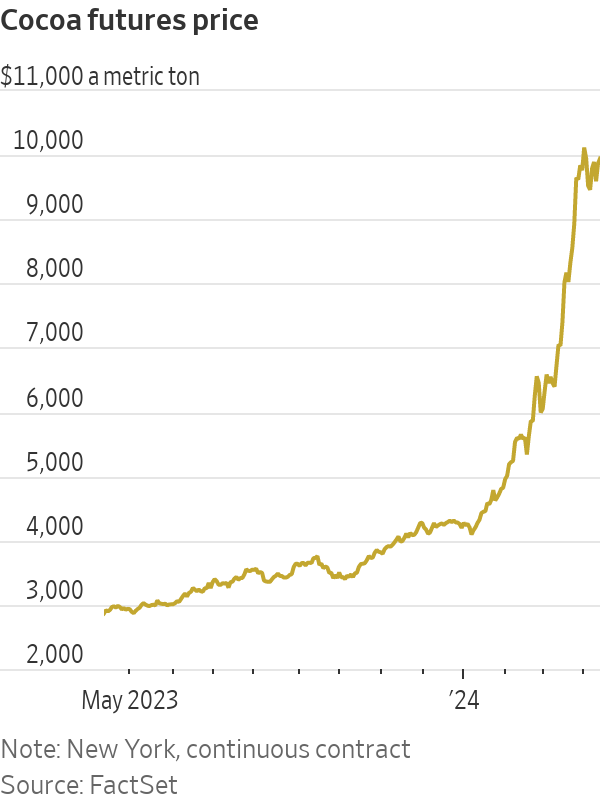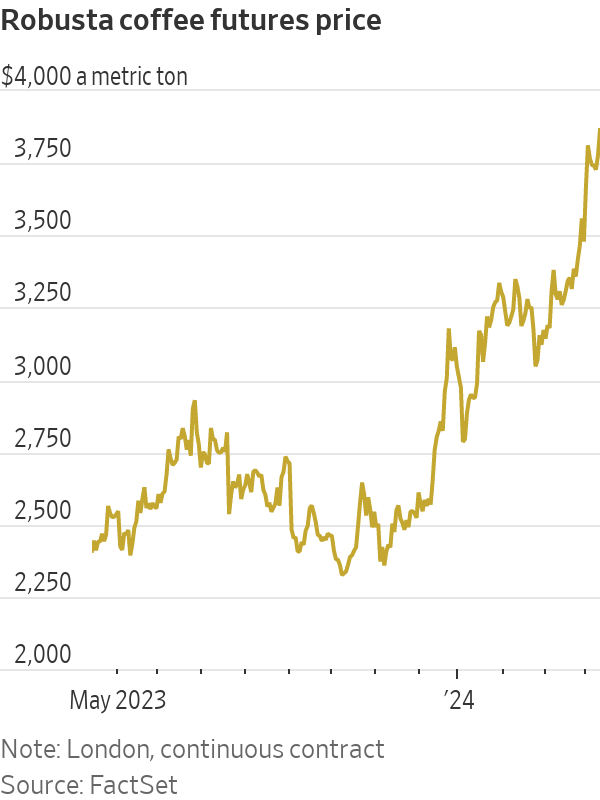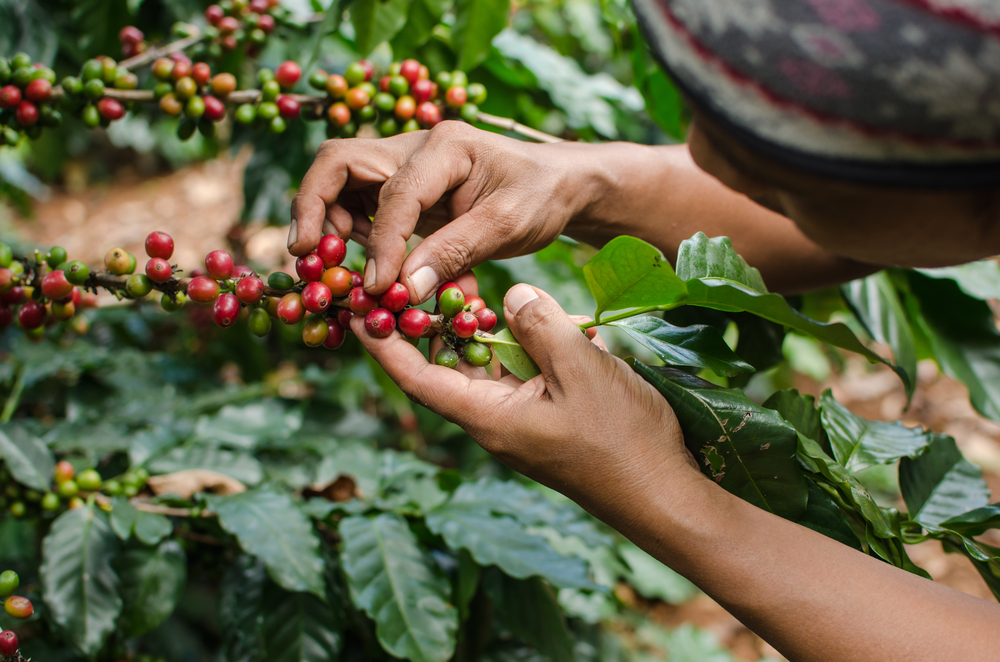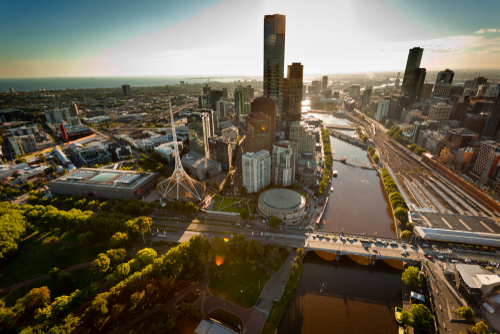Cocoa and Coffee Prices Have Surged. Climate Change Will Only Take Them Higher.
Some chocolatiers and coffee makers say they will have to pass on the extra cost to consumers
Global prices for cocoa and coffee are surging as severe weather events hamper production in key regions, raising questions from farm to table over the long-term damage climate change could have on soft commodities.
Cultivating cocoa and coffee requires very specific temperature, water and soil conditions. Now, more frequent heat waves, heavy rainfalls and droughts are damaging harvests and crippling supplies amid ever growing demand from customers worldwide.
“Adverse weather conditions, mostly in the Southern Hemisphere, have played an important role in sending several food commodities sharply higher,” said Ole Hansen , head of commodity strategy at Saxo Bank.
The spikes in prices are a threat to coffee and chocolate makers across the globe.
Swiss consumer-goods giant Nestlé was able to pass only a fraction of the cocoa price increase to customers last year, and it may need to adjust pricing in the future due to persistently high prices, a spokesperson said.
Italian coffee maker Lavazza reported revenue of more than $3 billion for last year, but said profitability was hit by soaring coffee bean prices, particularly for green and Robusta coffee, and its decision to limit price increases.

Likewise, chocolatier Chocoladefabriken Lindt & Spruengli said in its 2023 results that weather and climate conditions played a major role in the global shortage of cocoa beans that led to historically high prices. The company had to lift the sales prices of its products and said it would need to further raise them this year and next if cocoa prices remain at current levels.
Hershey ’s chief executive, Michele Buck , said in February that historic cocoa prices are expected to limit earnings growth this year, and that the company plans to use “every tool in its toolbox,” including price hikes, to manage the impact on business.
In West Africa, where about 70% of global cocoa is produced, powerhouses Ivory Coast and Ghana are facing catastrophic harvests this season as El Niño—the pattern of above-average sea surface temperatures—led to unseasonal heavy rainfalls followed by strong heat waves.
Extreme heat has weakened cocoa trees already damaged from heavy rainfall at the end of last year, according to Morningstar DBRS’s Aarti Magan and Moritz Steinbauer. The rain also worsened road conditions, disrupting cocoa bean deliveries to export ports.
The International Cocoa Organization—a global body composed of cocoa producing and consuming member countries—said in its latest monthly report that it expects the global supply deficit to widen to 374,000 metric tons in the 2023-24 season, from 74,000 tons last season. Global cocoa supply is anticipated to decline by almost 11% to 4.449 million tons when compared with 2022-23.
“Significant declines in production are expected from the top producing countries as they are envisaged to feel the detrimental effect of unfavorable weather conditions and diseases,” the organization said.
While the effects of climate change are severe, other serious structural issues are also hitting West African cocoa production in the short- to medium-term. Illegal mining poses a significant threat to cocoa farms in Ghana, destroying arable land and poisoning water supplies, and the problem is becoming increasingly relevant in the Ivory Coast, according to BMI.
The issues are being magnified by deforestation carried out to increase cocoa production. Since 1950, Ivory Coast has lost around 90% of its forests, while Ghana has lost around 65% over the same period. This has driven farmers to areas less suited to cocoa cultivation like grasslands, increasing the amount of labor required and bringing further downside risks to the harvest, the research firm said.
The Ivory Coast’s cocoa mid-crop harvest—which officially starts in April and runs until September—is expected to fall to 400,000-500,000 tons from 600,000-620,000 tons last year, with weather expected to play a crucial role in shaping the market balance for the season, ING analysts said, citing estimates from the country’s cocoa regulator. Ghana’s cocoa board also forecasts a slump in the harvest for this season to as low as 422,500 tons, the poorest in more than 20 years, according to BMI.
Neither regulator responded to a request for comment.

Meanwhile, extreme droughts in Southeast Asia—particularly in Vietnam and Indonesia—are resulting in lower coffee bean harvests, hurting producers’ output and global exports. Coffee inventories have recovered somewhat in recent weeks but remain low in recent historical terms. Robusta coffee has seen a severe deterioration in export expectations, while Arabica coffee is expected to return to a relatively narrow surplus this year, said Charles Hart, senior commodities analyst at BMI.
The global coffee benchmark prices, London Robusta futures, are up by 15% on-month to $3,825 a ton. Arabica coffee prices have also surged 17% over the last month to $2.16 a pound in lockstep with Robusta—its highest level since October 2022. Cocoa prices have more than tripled on-year over these supply crunch fears, and risen 49% in the last month alone to $10,050 a ton.
“Cocoa trees are particularly sensitive to weather and require very specific conditions to grow, this means that cocoa prices are especially vulnerable to extreme weather events, such as drought and periods of intense heat, as well as the longer-term impact of climate change,” said Lucrezia Cogliati, associate commodities analyst at BMI.
Cogliati said global cocoa consumption is expected to outpace production for the third consecutive season, with intense seasonal West African winds and plant diseases contributing to significant declines.
Consumers hoping for a return to cheaper prices for life’s little luxuries in the midterm may also be in for a bitter surprise.
“There is no sugarcoating it—consumers will ultimately be faced with higher chocolate prices, products that contain less chocolate, and/or shrinking product sizes,” Morningstar’s Magan and Steinbauer said in a report.
“We anticipate consumers could respond by searching widely for promotional discounts, trading down to value-based chocolate and confectionary products from premium products, switching to private-label from branded products and/or reducing volumes altogether.”
The record-breaking rally for cocoa and coffee is likely more than just a flash in the pan, according to Citi analysts, as adverse weather conditions and strong demand trends are likely to support prices in the months ahead. The U.S. bank estimates Arabica coffee futures in a range of $1.88-$2.15 a pound for the current year, but said projections could be lifted if the outlook for 2024-25 tightens further.
At the heart of it all, climate change is set to play a major role, as the impact of extreme weather events could exacerbate the pressure on cocoa and coffee supplies, according to market watchers.
“I don’t expect prices to remain at these levels, but if we continue to see more unusual weather as a result of global warming then we certainly could see more volatility in terms of cocoa yields going forward, which could impact pricing,” said Paul Joules, commodities analyst at Rabobank.
 Copyright 2020, Dow Jones & Company, Inc. All Rights Reserved Worldwide. LEARN MORE
Copyright 2020, Dow Jones & Company, Inc. All Rights Reserved Worldwide. LEARN MORE
This stylish family home combines a classic palette and finishes with a flexible floorplan
Just 55 minutes from Sydney, make this your creative getaway located in the majestic Hawkesbury region.
Continued stagflation and cost of living pressures are causing couples to think twice about starting a family, new data has revealed, with long term impacts expected
Australia is in the midst of a ‘baby recession’ with preliminary estimates showing the number of births in 2023 fell by more than four percent to the lowest level since 2006, according to KPMG. The consultancy firm says this reflects the impact of cost-of-living pressures on the feasibility of younger Australians starting a family.
KPMG estimates that 289,100 babies were born in 2023. This compares to 300,684 babies in 2022 and 309,996 in 2021, according to the Australian Bureau of Statistics (ABS). KPMG urban economist Terry Rawnsley said weak economic growth often leads to a reduced number of births. In 2023, ABS data shows gross domestic product (GDP) fell to 1.5 percent. Despite the population growing by 2.5 percent in 2023, GDP on a per capita basis went into negative territory, down one percent over the 12 months.
“Birth rates provide insight into long-term population growth as well as the current confidence of Australian families,” said Mr Rawnsley. “We haven’t seen such a sharp drop in births in Australia since the period of economic stagflation in the 1970s, which coincided with the initial widespread adoption of the contraceptive pill.”
Mr Rawnsley said many Australian couples delayed starting a family while the pandemic played out in 2020. The number of births fell from 305,832 in 2019 to 294,369 in 2020. Then in 2021, strong employment and vast amounts of stimulus money, along with high household savings due to lockdowns, gave couples better financial means to have a baby. This led to a rebound in births.
However, the re-opening of the global economy in 2022 led to soaring inflation. By the start of 2023, the Australian consumer price index (CPI) had risen to its highest level since 1990 at 7.8 percent per annum. By that stage, the Reserve Bank had already commenced an aggressive rate-hiking strategy to fight inflation and had raised the cash rate every month between May and December 2022.
Five more rate hikes during 2023 put further pressure on couples with mortgages and put the brakes on family formation. “This combination of the pandemic and rapid economic changes explains the spike and subsequent sharp decline in birth rates we have observed over the past four years,” Mr Rawnsley said.
The impact of high costs of living on couples’ decision to have a baby is highlighted in births data for the capital cities. KPMG estimates there were 60,860 births in Sydney in 2023, down 8.6 percent from 2019. There were 56,270 births in Melbourne, down 7.3 percent. In Perth, there were 25,020 births, down 6 percent, while in Brisbane there were 30,250 births, down 4.3 percent. Canberra was the only capital city where there was no fall in the number of births in 2023 compared to 2019.
“CPI growth in Canberra has been slightly subdued compared to that in other major cities, and the economic outlook has remained strong,” Mr Rawnsley said. “This means families have not been hurting as much as those in other capital cities, and in turn, we’ve seen a stabilisation of births in the ACT.”
This stylish family home combines a classic palette and finishes with a flexible floorplan
Just 55 minutes from Sydney, make this your creative getaway located in the majestic Hawkesbury region.






















